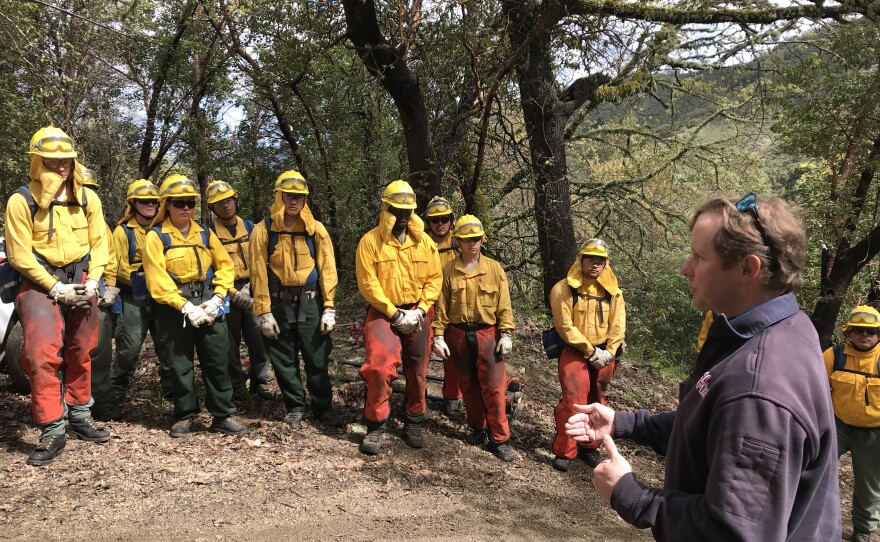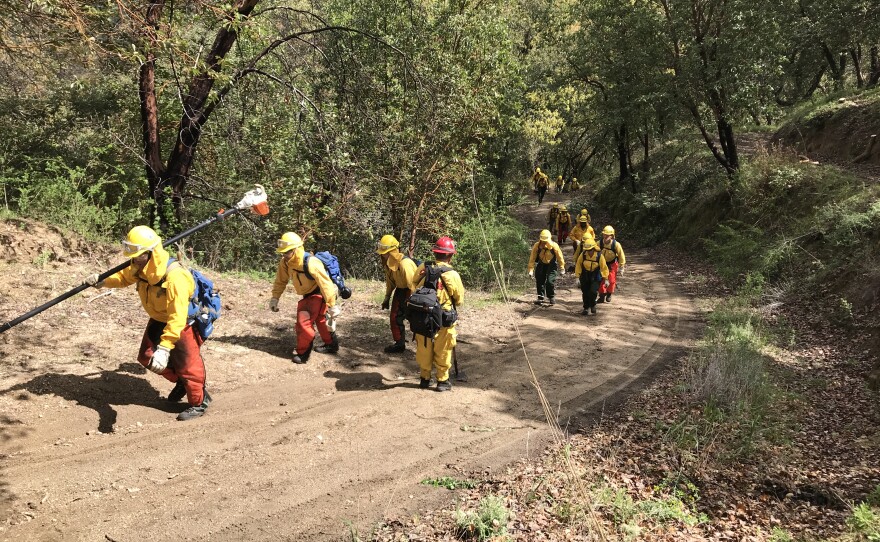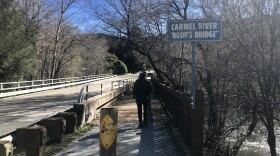Winter rain created lush green hillsides across California. Soon, summer heat will dry out this growth, creating fuel for wildfire. To prepare, Governor Gavin Newsom ordered fire prevention work in vulnerable communities across the state.
Newsom announced the plan in late March.
“We’ve got to be much more proactive. 1.9 million-acres burned last year,” Newsom said.
Tens of thousands of homes and hundreds of lives were lost, he added. So to speed up fire prevention efforts, Newsom lifted environmental regulations for 35 priority projects. Groups like the Sierra Club protested this move.
One of the priority projects is already underway in the mountains south of Carmel Valley. Work is beginning near a private community called White Rock Club. Here, about 100 cabins are nestled in the mountains; most are second homes.
Along White Rock Ridge, a 20-person crew will be clearing brush and cutting off low-hanging tree branches for months.
They’ve got a lot of work ahead of them; this project spans 10,000 acres. It’s called the Palo Corona-White Rock Fire Roads Project. Work will be done by hand and heavy equipment, reducing vegetation along the ridgeline and access roads.
Cal Fire Forester Jonathan Pangburn says they’re working in this area because it’s a strategic location for fighting wildfire. About three years ago, this is where firefighters held back the Soberanes Fire.
“White Rock Ridge ended up being, for a large portion of it, the primary fire control line during the Soberanes Fire that kept it from entering into Carmel Valley,” says Pangburn.
This narrow ridgeline stands between the Los Padres National Forest and the homes in Carmel Valley.
“This is our last resort. This line right here is like our last spot to hold fire before it goes through thousands of homes,” he says.
This is one of five priority projects happening across the Monterey Bay Area. These forest management projects range from creating fuel breaks to reducing vegetation.
The governor waived the California Environmental Quality Act, or CEQA, to speed up all 35 projects happening across the state. CEQA requires the identification and mitigation of environmental impacts, then sharing that information with the public.
Sierra Club California Director Kathryn Phillips says that was the wrong move.
“I think as a public interest organization, we're always anxious for more information not less,” Phillips says.
She’s concerned about long-term impacts to wildlife, habitat and other natural resources.
“How do we make sure that what they're doing doesn't endanger those? California Environmental Quality Act is a checking mechanism. And when governments start destroying those checking mechanisms, it creates uncertainty about how well they're doing their job,” says Phillips.
Cal Fire’s Jonathan Pangburn says although they don’t have to follow CEQA, it’s still informing how they’re approaching the Palo Corona-White Rock project.
“There are a number of species, and other resources of concern in our area, here on the Central Coast that we are absolutely making sure to protect as part of our overall project design,” Pangburn says.
Also, the state requires these projects have a registered professional forester on-site. Nadia Hamey, of Hamey Woods, is the one working on this project.
She leans against her grey truck just before heading out to the project site. There, she’ll identify plants and animals that need to be protected.
“The California red-legged frog and the California tiger salamander are a particular species of concern. The Smith’s blue butterfly, as I mentioned, is a buckwheat dependent species,” says Hamey.
She’s got a lot of supplies in the back of her truck: an ATV, detailed maps and flags. She’ll use the flags to mark habitats that Cal Fire crews should not clear out.
“We are hanging flags on every plant specimen that we want retained. So in the case of elderberry, if we have a whole patch of elderberry, we might, you know, have 15 flags kind of in the surround and that's a key to the operators to leave it alone,” Hamey says.
Hamey says doing this work proactively allows crews to give more care than during an emergency. That’s when dozers can haphazardly destroy these natural resources.
National Guard crews are helping Cal Fire with the fire prevention work across the state. Funding for the 35 projects comes from the 2018-2019 Forest Health and Fire Prevention budget. The projects will cost around $30 million.








